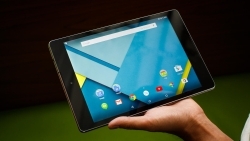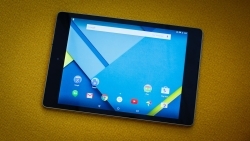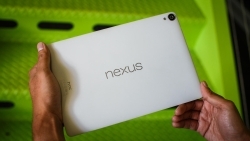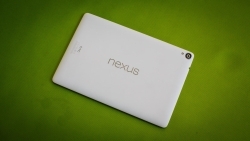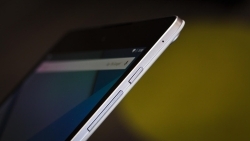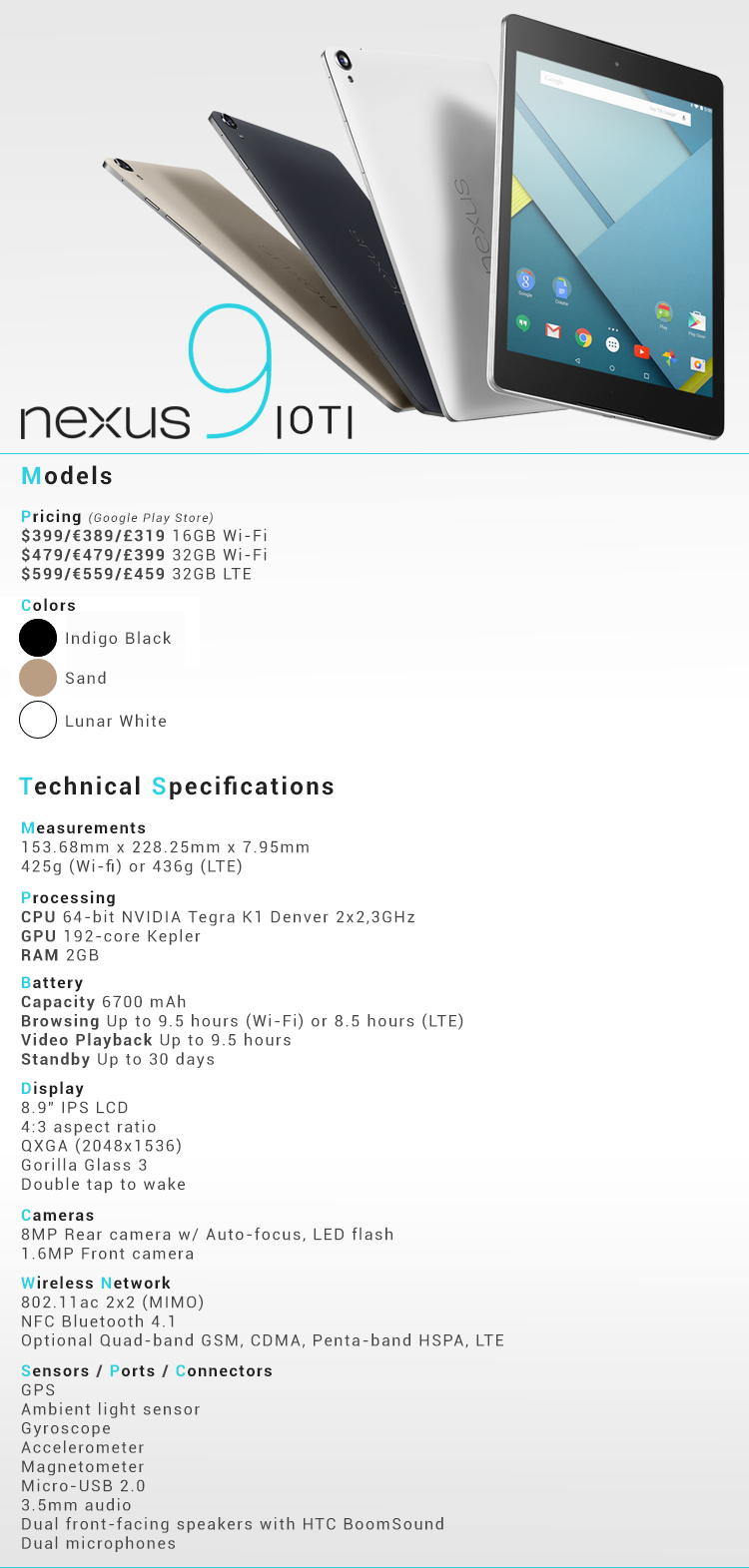

The Nexus 9 runs on the latest version of Android, 5.0 Lollipop. The OS has been greatly altered from the previous version to follow Google's new design philosophy called Material Design.
Key features are:
A refreshed notification system. Individual notifications are now displayed on cards to adhere to the material design language, and batches of notifications can be grouped by the app that produced them. Notifications are now displayed on the lock screen as cards, and "heads up" notifications can also be displayed as large banners across the top of the screen, along with their respective action buttons. A do-not-disturb feature is also added for notifications. The recent apps menu was redesigned to use a three-dimensional stack of cards to represent open apps. Individual apps can also display multiple cards in the recent menu, rather than only one entry per app; for example, a web browser can show all of its open tabs as individual cards.
Lollipop also contains major new platform features for developers, with over 5,000 new APIs added for use by applications. Additionally, the Dalvik virtual machine was officially replaced by Android Runtime (ART), which is a new runtime environment that was introduced as a technology preview in KitKat. ART is a cross-platform runtime which supports the x86, ARM, and MIPS architectures in both 32-bit and 64-bit environments. Unlike Dalvik, which uses just-in-time compilation (JIT), ART compiles apps upon installation, which are then run exclusively from the compiled version from then on. This technique removes the processing overhead associated with the JIT process, improving system performance.
Lollipop also aims to improve battery consumption through a series of optimizations known as "Project Volta". Among its changes are a new battery saver mode, job scheduling APIs which can restrict certain tasks to only occur over Wi-Fi, and batching of tasks to reduce the overall amount of time that internal radios are active. The new developer tool called "Battery Historian" can be used for tracking battery consumption by apps while in use. The Android Extension Pack APIs also provide graphics functions such as new shaders, aiming to provide PC-level graphics for 3D games on Android devices.
A number of system-level, enterprise-oriented features were also introduced under the banner "Android for Work": Samsung contributed its Knox security framework for segregating personal and work-oriented data from each other on a device, along with accompanying APIs for managing the environment. Devices can also be configured so that users do not have to unlock their device with a PIN or pattern if it is within a trusted, physical location, or is in proximity to a user's Android Wear device. Device encryption will be enabled by default.

Reviews
-Phonearena.comFinal Score: 9.3/10
Modesty, that’s what makes the Google Nexus 9 an unsuspecting threat in the tablet space. The specs and design aren’t insanely out there, to drastically separate it from the existing crop of competition, but rather, it’s what it delivers with its overall package that gives it such an inviting presence – one that undoubtedly embodies all the qualities we want in that near-perfect tablet.
We’ve explored its humbling design, dived deep into the new Android 5.0 Lollipop experience, and even put it through one intensive battery testing, to come to the conclusion that it’s arguably one of the most delightful tablets to launch this year. Best of all, its starting price of $399 undercuts many of its rivals in the process, since the pricing alone goes a long way in giving it some serious value. For the money and all, the Nexus 9 doesn’t disappoint with its specs sheet, performance, and software experience.
HTC has been out of the tablet game for a considerable amount of time, failing to earn its presence in the space, but with the arrival of the Google Nexus 9, they’ve undeniably brought together something that follows in tradition to the Nexus line. Conversely, it’s Google that takes a lot of credit, seeing that Android 5.0 Lollipop shows why it’s the most advanced tablet platform around!
Everything about the Android experience has been refined and enhanced with not only some features that are “in-your-face,” but they’ve meticulously ensured to us that it has far more depth than its rivals. From being a fun tablet for playing games, to a productivity focused one that’s handy for pulling out work while on the road, the Google Nexus 9 has a presence that resonates deeply in the space. And we can’t neglect to mention that it’s super affordable in the process! What more can we ask, seriously?
Pros
The pricing is absolutely competitive at $399
Material Design gives the interface an inviting presence
Android 5.0 Lollipop dishes us several cool features
Battery is far more lasting than its contemporaries
Precise color reproduction with its display
Cons
Hollowness with its construction
Low lighting performance is weak with its camera
-EngadgetFinal Score: 8.5/10
I didn't expect to feel so torn about the Nexus 9. On the one hand, Android 5.0 Lollipop is refreshing, what with its snappiness and welcoming redesign. On the other, I can't help but feel a little frustrated that Google and HTC compromised on the Nexus 9's screen, speakers and design. I get the rationale. The software's the real highlight here, so they didn't feel the need to go bonkers with the hardware niceties (and the costs that come with them). What that all boils down to is a tablet that's stunning in some ways and seemingly average in others. Long story short: If you want to live on Android's bleeding edge, buy a Nexus 9. Buy it because of Lollipop. Those few shortcomings won't overshadow all the good that Google and HTC have done here. But if that's not you -- if you don't demand the latest software that springs forth from Mountain View's depths as soon as it's ready -- there are plenty of attractive options that might fit your life a little better.
Pros
Android 5.0 Lollipop runs like a dream
Material Design face-lift is warm, welcoming
K1 chipset is plenty powerful, despite benchmark oddities
Cons
Screen is solid, not jaw-dropping
BoomSound speakers not as good as M8's
No expandable memory
-The VergeFinal Score: 7.8/10
Unfortunately, the Nexus 9 just isn’t as good as it needs to be. It’s priced as high or higher than Apple’s tablets, but doesn’t offer anything in terms of hardware or performance to sway someone from just purchasing an iPad instead. The Nexus 9 would make a killer $249 or $299 tablet, but at $399, even last year’s iPad Air is a better buy for the vast majority of people. And if you want something smaller than the iPad Air, last year’s iPad mini 2 undercuts the Nexus 9 by a full $100, while offering a better experience all around. It’s hard to recommend the Nexus 9 to anyone outside of diehard Android fans.
Beating the iPad is hard. Many have tried, many have failed. The Nexus 9 is Google’s closest shot yet, but it still misses the mark. See you next year, Google.
Good Stuff
High-resolution, 4:3 display
Good battery life
Great speakers
Bad Stuff
Build quality issues
Sluggish performance
Lack of tablet-optimized apps
OP will be updated with new reviews as they appear.

